Loyalty, Revolution and Victory: In The Gym With Ricardo Lamas
Loyalty, Revolution and Victory: In The Gym With Ricardo Lamas
Former UFC featherweight title challenger Ricardo Lamas recounts family history and championship aspirations.
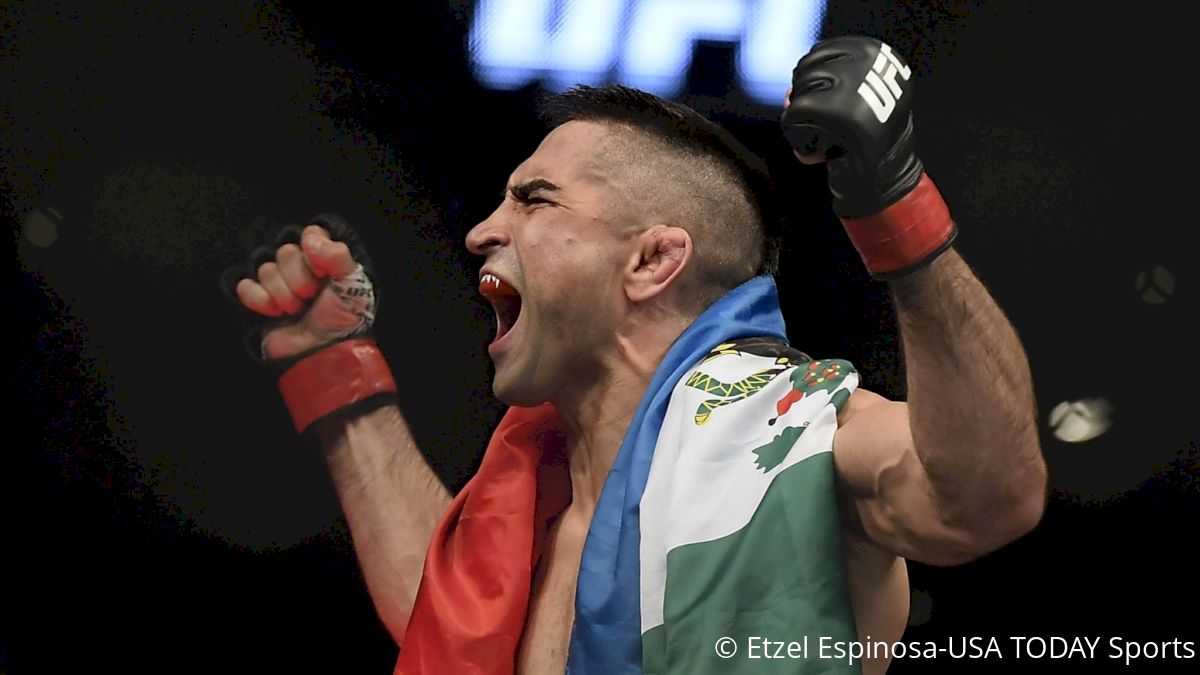
By Elias Cepeda
Cuba is close to Ricardo Lamas' heart, but he's intentionally never set foot on Cuban soil. The American has flown Cuba's flag along with Mexico's during his fights to honor his Cuban father and Mexican mother and their heritages.
The featherweight title contender speaks Spanish and has proudly fought in Mexico. When asked if he's ever been to Cuba, Lamas says he would love the chance to do the same in his father's homeland. After all, he's of Cuban descent and he'll soon be back in Miami, where he's completed his training camps for the better part of a decade, only some 90 or so miles away from Cuba.
However, he says he won't visit the island until it is freed from the party and people who ran his father out of the country a half century ago.
"I'll never go there until Cuba is liberated," Lamas tells me over lunch.
"It would be a slap in the face to my father, who was forced to leave to save his life."
It's early June and Lamas is in the beginning stages of his training camp for UFC 214, which takes place Saturday in Anaheim, California. We're in suburban Chicago, near where Lamas grew up, working through appetizers of corn chips, guacamole, and deconstructed elotes when Lamas begins talking about Cuba and his family.
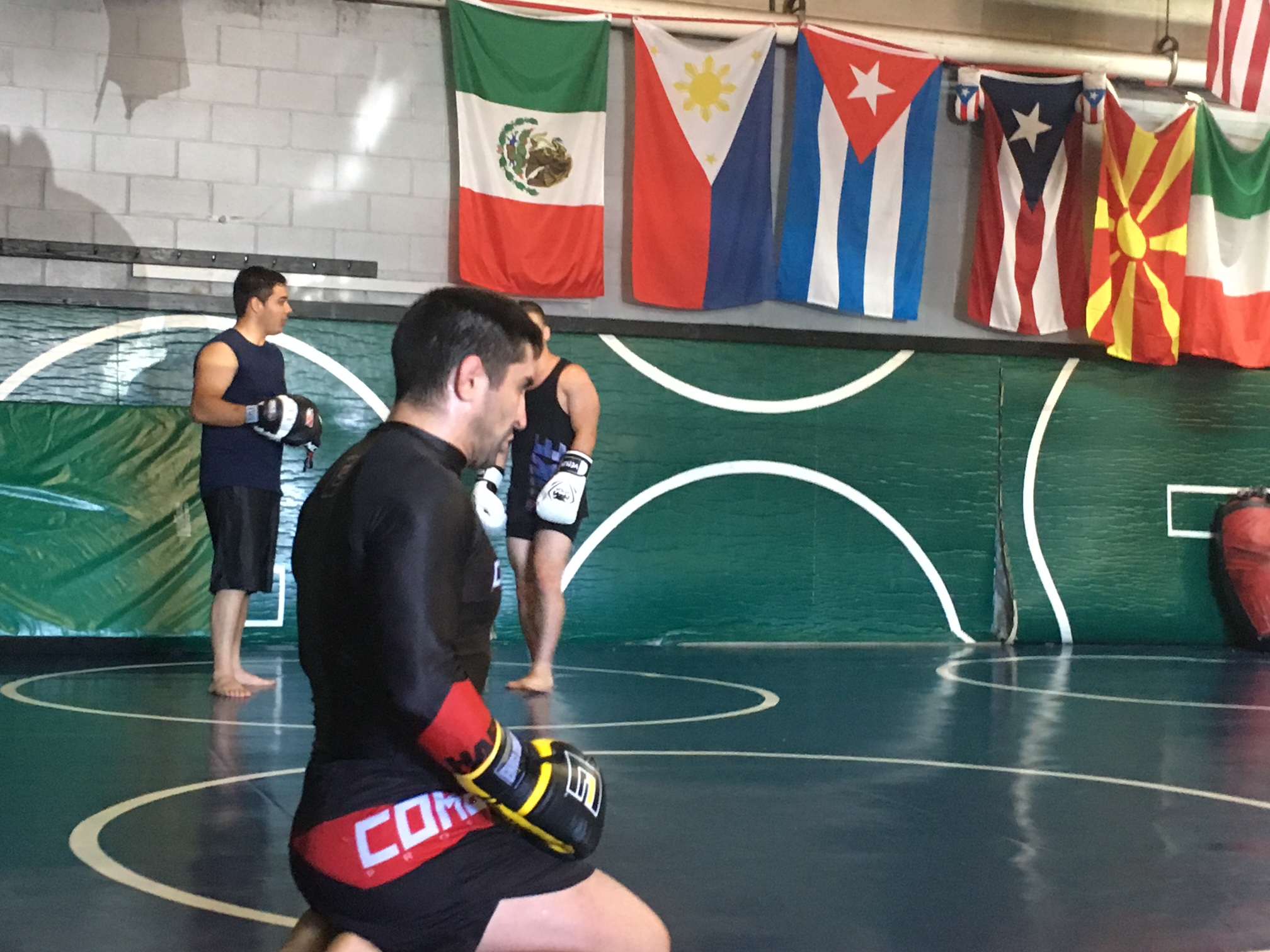
Cuba, of course, has been in the grips of the autocratic Castro family since Fidel led a successful revolution against the dictator who preceded him, Fulgencio Batista in 1959. Batista allowed foreign governments and businesses from nations such as the United States to loot and plunder Cuba's resources, all but turning the proud nation into a brothel-casino for wealthy North Americans and Europeans.
Like many others disgusted by Batista's dictatorial rule, Jose Lamas became an activist against the regime. Ricardo's father would go on to become the national head of the students revolutionary movement.
Jose hoped that a revolution would bring about new democratic freedoms. Soon after the revolution succeeded, however, Jose realized that freedom was not coming.
"My father helped the revolution at first. Then he became a teacher. He went out into the country to teach people and help educate but then he started realizing the brainwashing that was going on with people in Castro's circle," Lamas continues.
"They started telling him he needed to do this or that, violent things sometimes. He told them, 'I'm here to be a teacher. I'm not interested in this.' Castro and the revolution became dictators just like they'd fought against."
Indeed, though the Castro regime would bring notable improvements to Cuba such as health care and some world-class educational systems, Cuba never became free.
Soon after the revolution deposed Batista, Castro and other leaders such as Che Guevara did much more than oust wealthy capitalists -- they also summarily persecuted and executed many others, from peasants to professors, without anything resembling due process in obvious attempts to stamp out criticism and dissent in the nation.
Lamas says his father's eyes were opened to Castro's despotic tendencies shortly after he took power, and so Jose found himself fighting yet another dictator as a leader of an underground counter-revolutionary movement.
Jose fought that fight but eventually realized that his life was in danger and fled the country. Jose Lamas made it, but may of his compatriots did not.
In fact, not long after the political exile found safety for himself outside of Cuba, the man he left in charge was captured and executed.
"Castro's government had infiltrated their counter-revolutionary group," Ricardo goes on.
"My dad's second-in-command was captured not long after my dad got out. They captured him, tried him in a fake trial, sentenced him to death, and then executed him in 23 days."
Soon Lamas will be back training at the MMA Masters gym in as close to a visitable motherland as Cuban exile families have -- Miami. Right now, the fighter is getting his training camp started with Mac Ramos at Team Top Notch in the Chicago suburb of Villa Park.
Lamas has kept his home in the Chicago area despite spending so much time preparing for fights in Miami. He's considered buying property with family in Miami, but Lamas has stayed a Chicago-area guy in many ways throughout his elite WEC and UFC run.
It was Lamas' first MMA coach Ramos who originally took him to Miami to train with the folks at MMA Masters.
"Mac loves Miami and one winter he suggested we get out of the cold up here and go train in Miami because he knew people down there," he recounts.
"I was already fighting and winning when I first went down there. I got my ass kicked though, and so I realized I needed to train with those guys more."
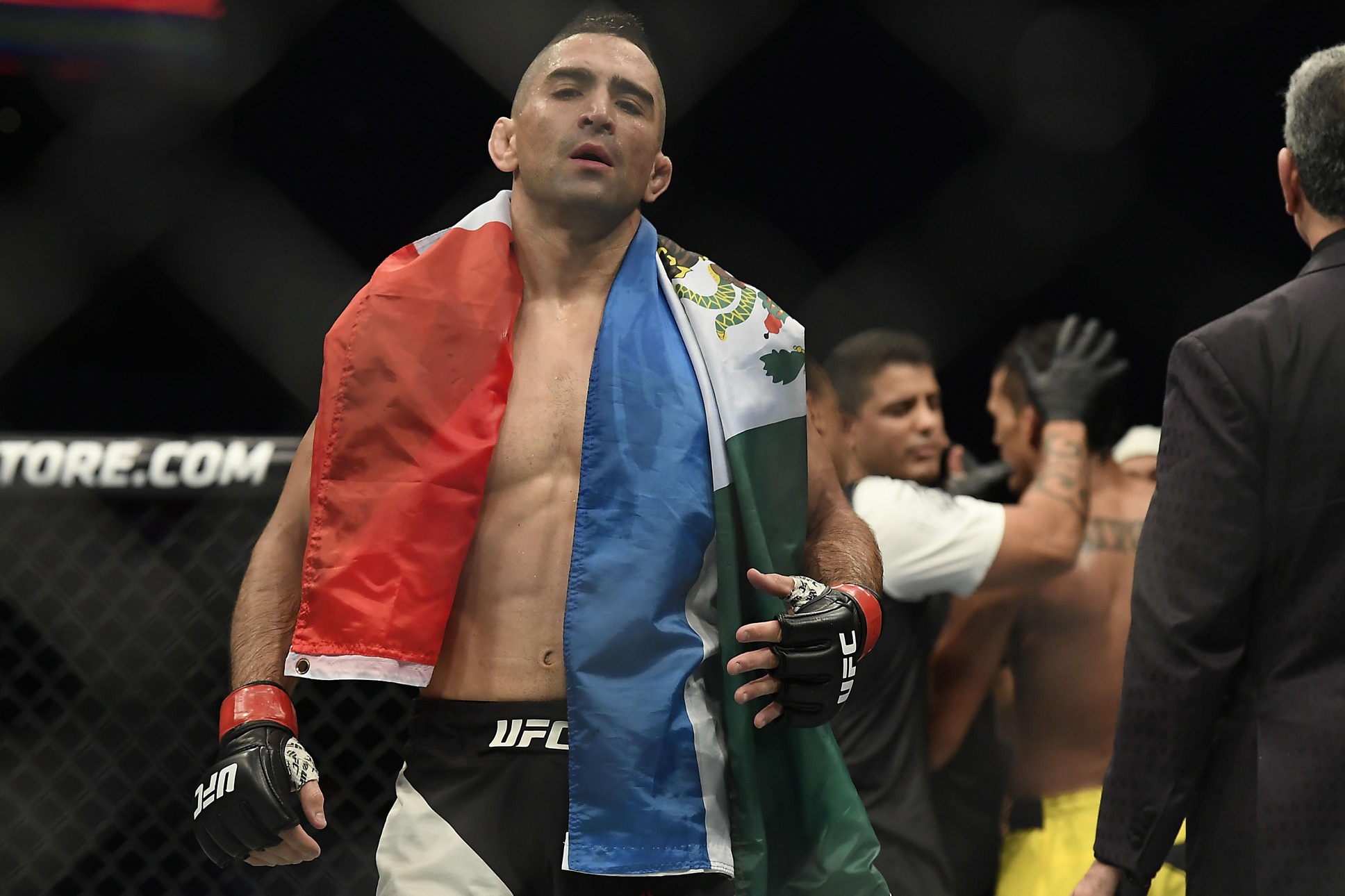
Nov 5, 2016; Mexico City, Mexico; Ricardo Lamas (red gloves) defeats Charles Oliveira (blue gloves) during UFC Fight Night at Distrito Federal. Mandatory Credit: Etzel Espinosa-USA TODAY Sports
That trait in Lamas -- seeking out challenging fire to forge character and improved skills -- is a seemingly overarching one. "The Bully" has always jumped in the deepest water available and sought fights with the best available.
Ramos -- who has produced many regional- and international-level fighters -- almost certainly never planned to have his charge move most of his training camps to Miami permanently. Team Top Notch is still very much Lamas' home, and they are certainly proud of him -- the fighter's image is emblazoned on its website and all over the walls in the form of fight-card posters inside the gym.
Though he does most of his fight camp work at MMA Masters, Lamas never actually left his hometown team, something common in the fight world. Still, he can't deny that there has sometimes been a bit of tension given that his coaches have to share responsibility for him.
"I can't say it has always been an easy thing," he admits.
"But no one has ever said anything negative to my face. I try to stay clear of if different people have criticisms or negative feelings. I've got good coaches out there, and good ones here. Mac has come out to my camps down there as well."
When he felt the need, Lamas moved on forward with his career and adjusted training approaches. Still, watching him work with Ramos earlier in the day inside Team Top Notch, it's clear the two have a strong connection.
In his second workout of the hot day, Lamas did five rounds of pad work with Ramos, who coached him through and held for crisp, powerful combinations despite being a bit under the weather. Lamas' first workout of the day came immediately prior to that pad work, over at Training For Warriors.
At TFW, Lamas led his longtime teammate Mike Santiago and myself through an hour-long strength and conditioning workout. "Santi," as he is called by Lamas and everyone else I see him interact with throughout the day, is a surging lightweight prospect.
At the time, Santiago was riding an eight-fight win streak and eager to sign his next bout agreement. A month later, he'd get it in the form of a Dana White Contender's series bout to take place in August.
Santiago is at the conditioning gym before Lamas. He waits for his teammate outside of the strip-mall storefront, seated and looking down at his phone.
When Lamas arrives, the two move inside and begin to chat. It turns out that Santiago waited outside to help keep his temper under control.
There is another fighter inside the gym who Santiago says he saw make disparaging comments about Team Top Notch on the internet. When you've trained with a team since you were a teen, as Santiago has with his, you take insults like that to heart.
Lamas listens to Santiago, asks some follow-up questions to better understand the situation, and then strikes an empathic leader's chord. The response from the team leader comes back something to the effect of, yeah, screw that guy, but he's not even a real fighter anyway, so don't sweat him.
Lamas is old school enough to get and care about team disses, but he's also enough of a sage veteran to know that the more nonsense that can be dismissed and disregarded out of hand, the better off a fighter and person will be in the long run.
Lamas leads the training. He's devised the workout and written it up on a whiteboard.
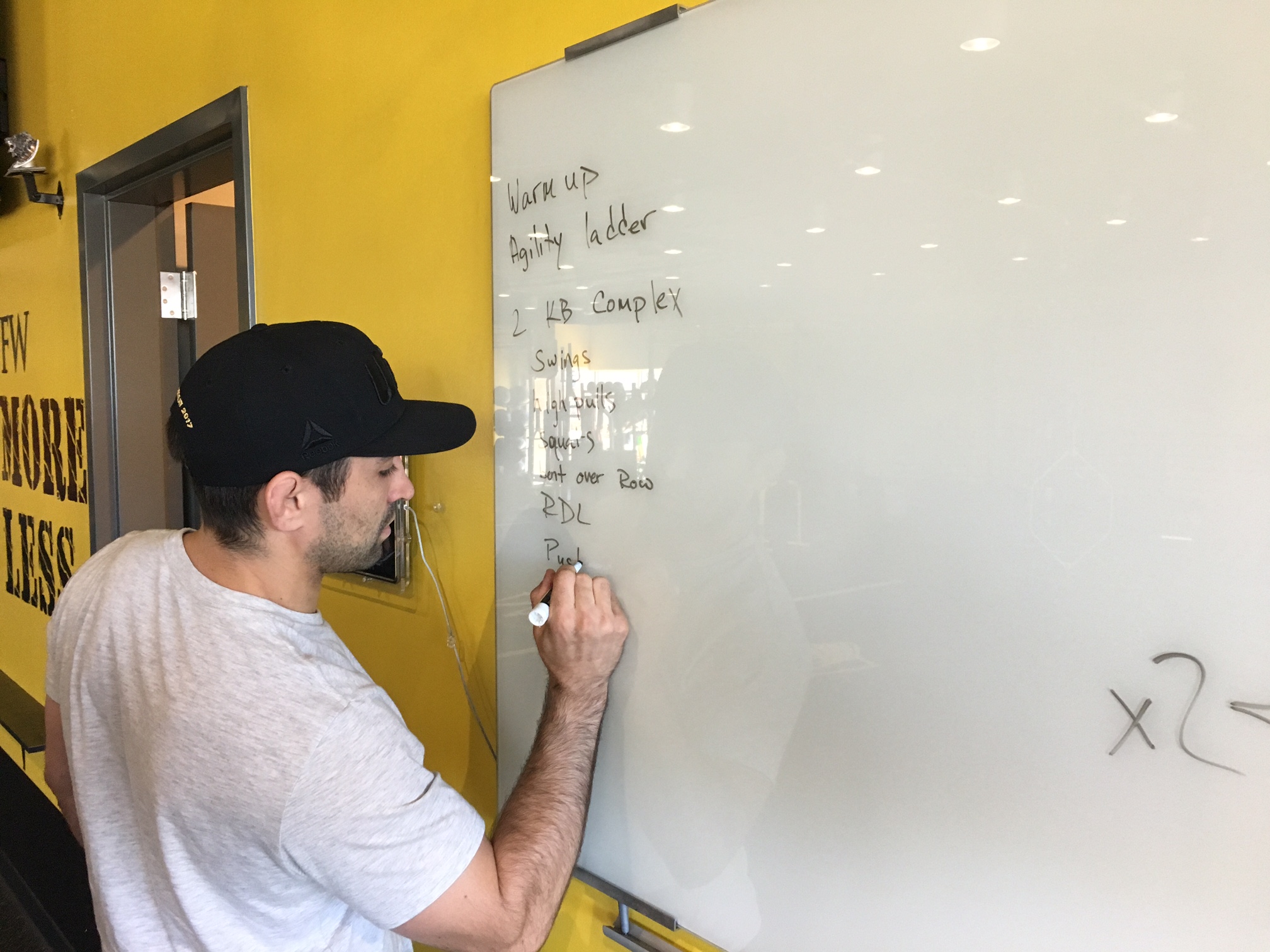
There's agility work, there's lifting, there's swinging, and a whole lot that will leave my lower back and legs good and sore for days afterward. For Lamas and Santiago, however, the workout is challenging, but also something they do three times a week in addition to all their fight-specific work like grappling, pad and bag work, and sparring.
For normal people in even excellent shape, the morning's kettlebell-heavy strength and conditioning workout would be more than enough on its own to stay fit if done a few times a week. Lamas dries off, drinks some water, and then hops into his truck to head right over to his next workout, just minutes away.
By the time I arrive at Team Top Notch, Lamas and Santiago have arrived. Ramos and another team member are there as well.
Three of them chat in Ramos' office, near a gym bathroom where Lamas sits. It doesn't take long for the others to start teasing Lamas for being in there for what they think is too long.
Unabashed, Lamas shouts back out confidently at them from inside the bathroom to laughs. A young athletic looking man in a tank top hovers nearby.
When Lamas returns to the group, he introduces the young man to his coach.
"Mac, this is Ronny," Lamas says.
"He wants to fight."
Ronny is a student who wrestled for nearby Elmhurst College, where Lamas himself once went to school and wrestled and where he now still stays active, assisting with coaching.
Ronny used up his eligibility as a college wrestler and wants to begin training to fight. He's not done anything combat-sport related except for wrestling, so far, but Lamas later tells me at lunch that he expects that experience and skill set alone to take the kid a long way.
"I don't try to convince people to fight because it's not something that just anyone can walk in and do," he says later, when I ask him what prompted him to bring Ronny into the gym.
"But his wrestling ability alone should carry him far, even from the start. He's like me -- he wrestled, loved it, and still wants to compete now that wrestling is done."
"Santi" gets Ronny set up with hand wraps when the team realizes that the ones the newcomer brought with him were far too small. They tease him a bit for it, and then Santiago brings Ronny a pair of his own, to keep, which seems to really touch the college athlete.
"It's no big deal, man. I have a bunch of them," he tells the rookie.
As Ronny learns to wrap his hands with the cloth meant to encase and tie together the fist to protect against friction and impact, Lamas wraps his own hands and takes apparent glee in regaling the group, and maybe especially Ronny, with a story of a time he suffered a bad eye injury during training in this very gym years ago.
"He hit me right in the eyeball, and I made the mistake of blowing my nose -- poof! It blew up," he laughs.
"My face swelled up and I looked like Sloth from 'The Goonies.' It hurt, bad. I couldn't move my eyeball without it feeling like I was getting stabbed in the eye for weeks."
There are many situations in which fighters eventually learn from others' advice or painful advice not to blow their noses… when your nose is broken and when you've been socked pretty good in the eye are two such situations. Lamas wasn't deterred from continuing fighting when it happened to him -- a case of serious eye trauma that he looks back on as comical -- and hopeful fighters like Ronny have to be similarly stalwart to get their careers off the ground.
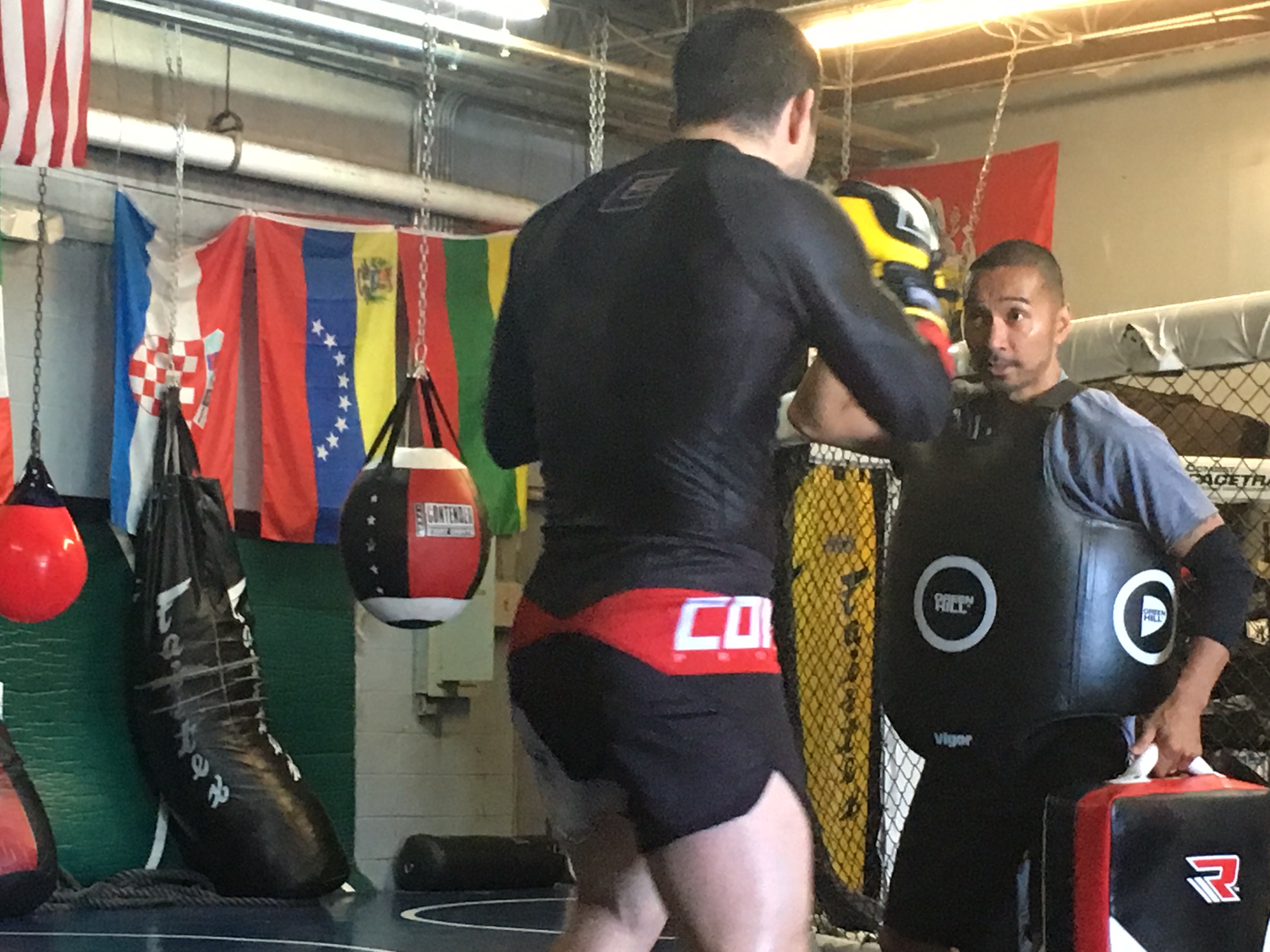
Ronny gets wrapped and gloved-up and then paired with a teammate who will take him through basic punches and combinations for a while. A few feet away on the blue wrestling mats of the gym, Ramos gears up with pads and a belly pad to hold for Lamas to work on his punches, elbows, knees, and kicks.
The workout lasts five five-minutes rounds -- the same as a UFC championship fight.
In the first round, Ramos holds boxing mitts to catch Lamas' punches. In round two, the coach is holding rectangular cube Muay Thai pads.
In round three, Ramos brings out the kick shield and hands it off his lead leg and has Lamas finish his punch combos with angles and big leg kicks. In round four, Ramos brings out the micro-mitts to work on punch precision.
In between the fourth and fifth rounds, Lamas, still going strong, looks over at the hulking and game Ronny, who has more than begun to tire in the midst of likely his first-ever striking training.
"It really burns your shoulders, right?" Lamas asked Ronny, with a smile.
The college wrestler seems to exhale, smile, and affirms. At least he knows that it's normal and that everyone gets tired from this stuff, now.
In the fifth and final round, Ramos uses both the micro-mitts and the kick shield to cue Lamas for a different set of sequences.
With his second and final workout for the day now complete, Lamas spends the next half hour helping coach Ronny -- teaching him partner drills to do and watching him practice, repetition after repetition.
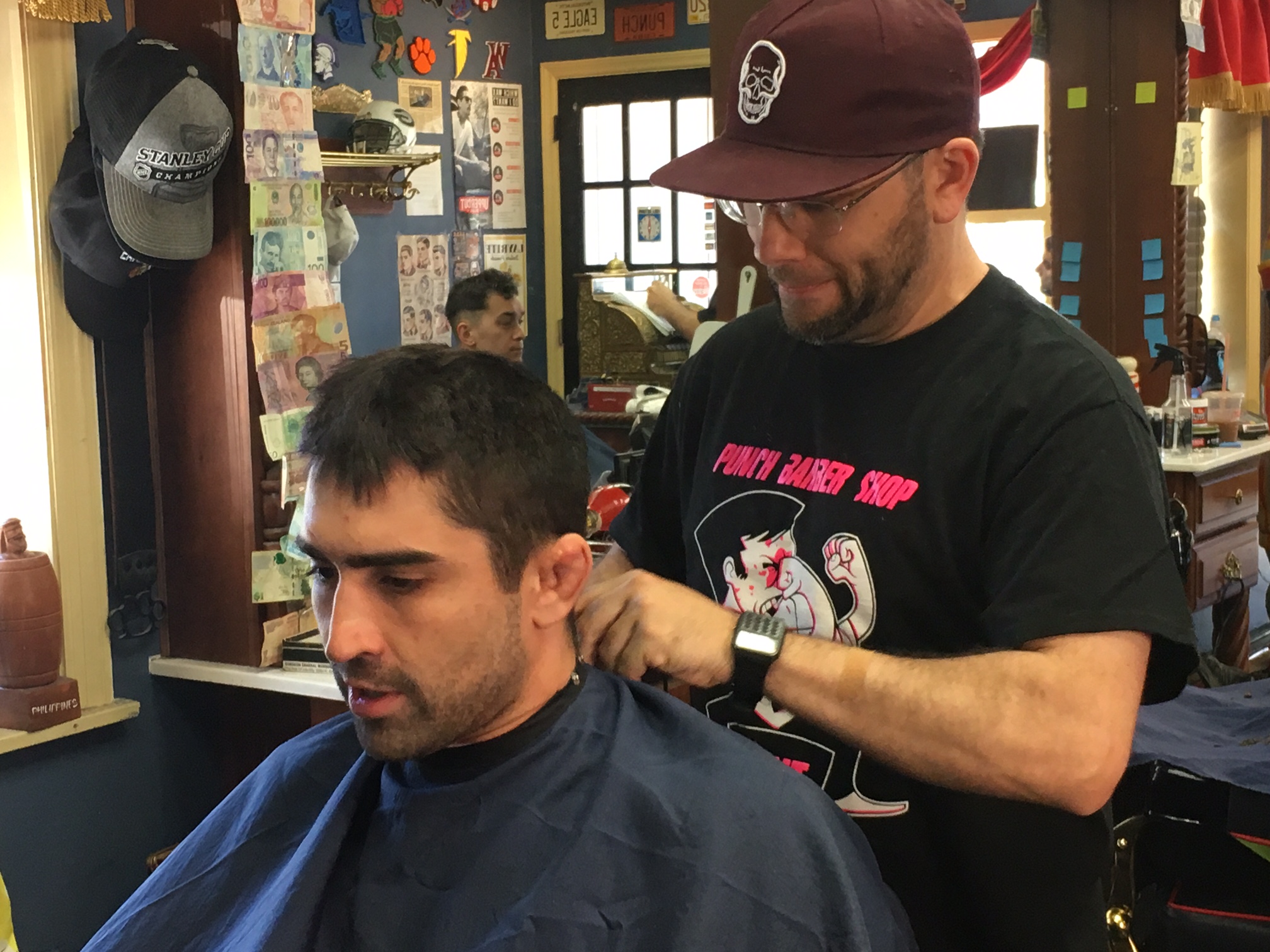
When that's done, Lamas takes off his black, long-sleeved rash guard and hits the shower. The fighter's next stop is at his barber shop, just a few miles away.
When I walk into the packed shop, Lamas is already speaking with his barber, Vinny.
Vinny's family owns the popular outpost, and Lamas later breaks down all the family members, including Vinny's mother, who also work in the shop.
Lamas leans up against a wall in the rear of the front room next to the jokester Vinny, who is cutting another client's hair. Every chair in the place is busy, and there looks to be another 10 people waiting.
With an estimate from Vinny as to how long the expected wait is going to be, Lamas and I head out to an upscale but laid-back Mexican restaurant a couple blocks away. It's seated at that modern cantina's bar, while drinking water and eating mostly veggies and lean meat (though it's still early enough in camp for Lamas to eat a couple chips and some cheese), that Lamas discusses Cuba, family, loyalty, and freedom.
It's also where we discuss his career. Lamas admits to being momentarily disappointed when his originally scheduled UFC 214 opponent, fellow former title-challenger Chan Sung Jung, was forced out with a knee injury.
Instead of fighting the well-known "Korean Zombie," the 35-year-old Lamas is now set to take on Jason Knight, a red-hot but not yet popular fighter 10 years Lamas' junior and a good deal larger.
"I was very excited for the fight with 'Korean Zombie' since he's a big name so there was a little letdown at first," Lamas concedes.
"The thing is, I've seen Knight fight, and he's a very tough guy. He just isn't as well known yet. So, it's another tough opponent but without the name recognition. In the end, however, it really doesn't matter who I fight at this point."
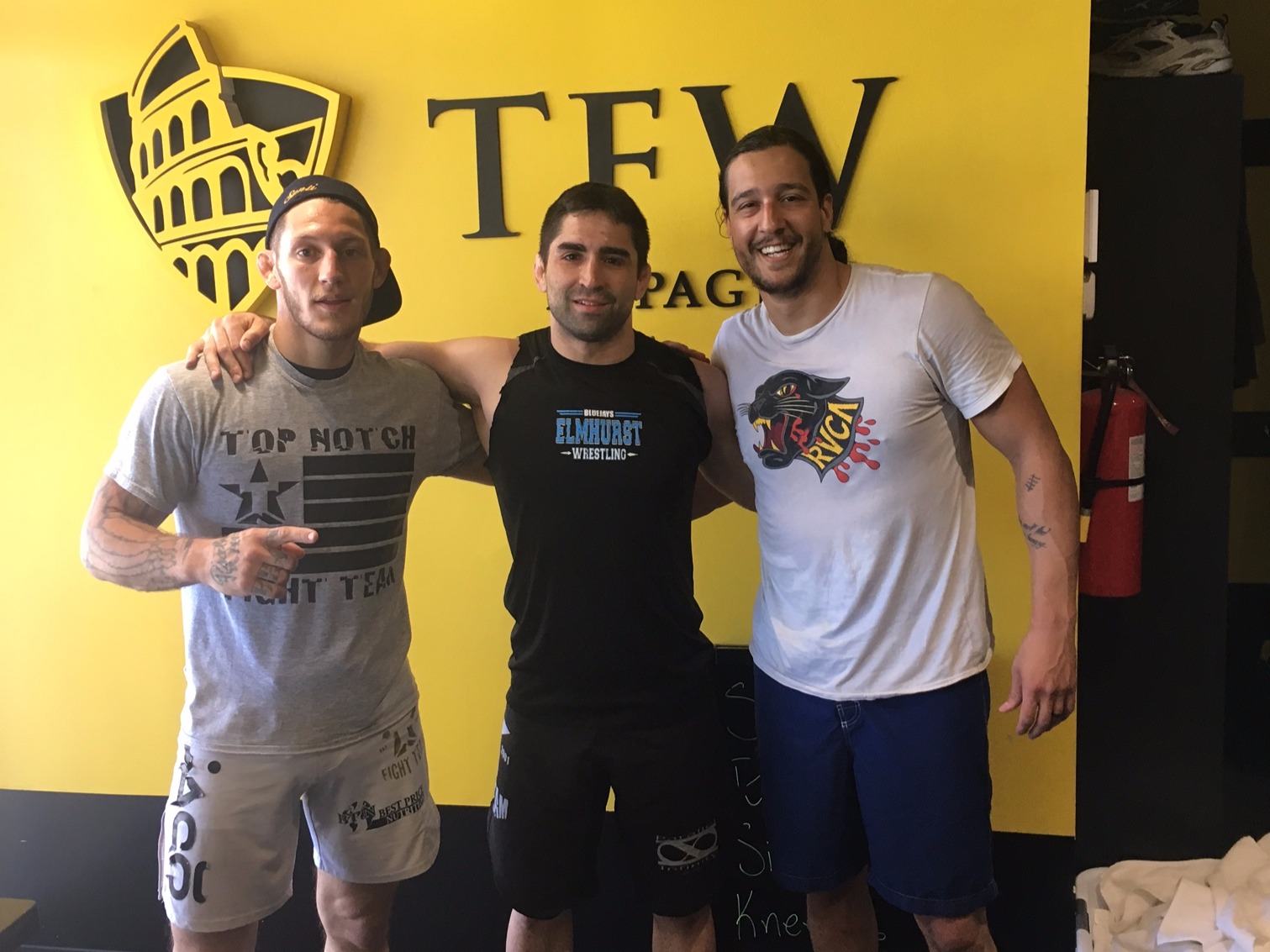
Lamas is ultimately happy to be fighting again, period. He hasn't fought since last November, when he scored an impressive submission victory over fellow contender Charles Oliveira at "The Ultimate Fighter: Latin America 3" finale in Mexico City and got back on the winning track.
With Oliveira coming in heavier than their contracted weight limit, among many other prior false starts with the matchup, the fight was one that posed many challenges to Lamas outside of the cage as well as in it. He surmounted all of those hurdles and rebounded after losing a decision in his previous fight to Max Holloway in a competitive and thrilling contest at UFC 199.
That loss to Holloway burns a little more today for Lamas than usual, perhaps. Only three days prior, he watched Holloway become the feathweight world champion by knocking out the greatest featherweight in history -- Jose Aldo. In 2014, Lamas went the distance with Aldo but lost by decision.
In about a year's time, Holloway followed up beating Lamas by becoming the world champion, and so Lamas understandably feels annoyingly close to the situation.
"It was a little hard to watch that fight," he admits.
Still, Lamas feels that there's opportunity in the timing.
"Holloway definitely beat me, but it was a good fight, a competitive one," he correctly opines.
"The Aldo fight, that one bothers me because it took me too long to get comfortable and fight like myself. I gave him too much respect at first, and by the time I was on him, in the fifth, there wasn't enough time left."
Lamas knows that, even in his mid-30s, he still has the opportunity to once again surge ahead in the wide-open featherweight division. If he beats Knight on Saturday, Lamas will have won three out of his last four fights.
In the UFC, Lamas has only lost to champions and fellow title-contenders Holloway, Aldo, and Chad Mendes. While Lamas may no longer be young for a featherweight, he's still clearly near the top of the division, with real momentum going his way and no visible decline yet in reflexes or skills.
With a new champion at featherweight, and the old new one -- Conor McGregor -- out of the picture for now, there's no real reason to believe that it has to take many more wins for Lamas to find himself back in the title picture.
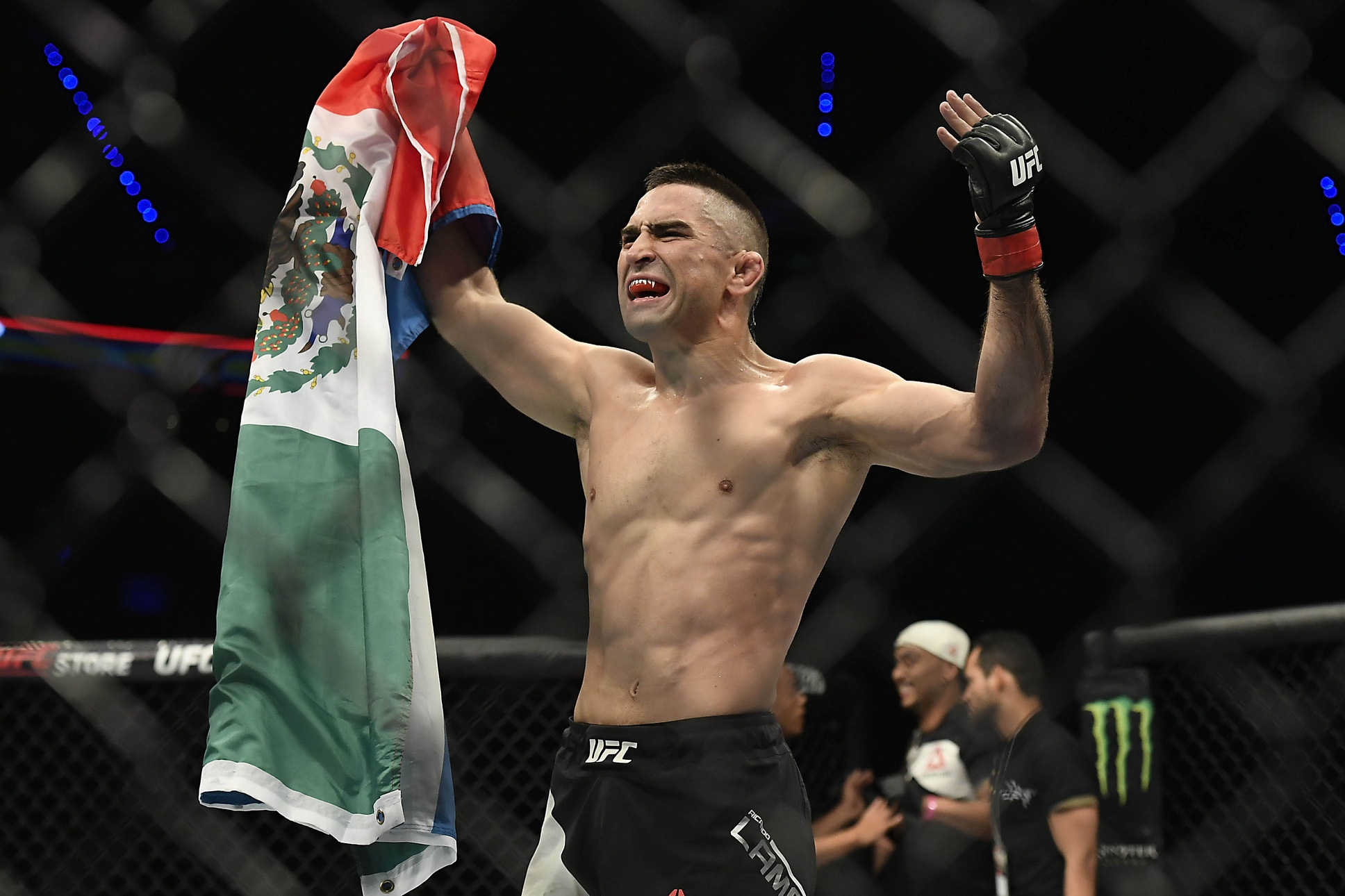
"Absolutely, the division feels wide open," he says.
"There's a lot of possibility at featherweight, and there's a lot of possibilities for me."
That drive to reach the mountain summit still moves Lamas. But so does the journey itself.
"I've always been in the sport to become the best," he concludes.
"I'll always want to be the best and work to be the best as long as I'm fighting. I also just enjoy being a fighter. I enjoy the training. I love it. I love the competition, in and of itself."
A decade into his MMA career, Ricardo Lamas clearly still has love for it. He loved fighting from the start, he says.
He loved it enough to start fighting right away with just a few months of MMA training, he loved it enough to often fight on short notice, through many cancellations and opponent changes coming up through the ranks.
In that way, not much ever really changes for fighters. Challenges keep popping up in less-than-ideal circumstances, opponents keep changing, and the grind never gets easier.
Some people, however, never seem to mind the hard work. Some people, the ones who stick with fighting, aren't scared off by any of it -- the pressure, injuries, drama, high-stakes -- in fact, they relish overcoming it all.
"There's nothing like getting your hand raised after a fight," Lamas says.
"I can't wait to get back in there and have that happen, again."
All Photo Credits: Elias Cepeda
Cuba is close to Ricardo Lamas' heart, but he's intentionally never set foot on Cuban soil. The American has flown Cuba's flag along with Mexico's during his fights to honor his Cuban father and Mexican mother and their heritages.
The featherweight title contender speaks Spanish and has proudly fought in Mexico. When asked if he's ever been to Cuba, Lamas says he would love the chance to do the same in his father's homeland. After all, he's of Cuban descent and he'll soon be back in Miami, where he's completed his training camps for the better part of a decade, only some 90 or so miles away from Cuba.
However, he says he won't visit the island until it is freed from the party and people who ran his father out of the country a half century ago.
"I'll never go there until Cuba is liberated," Lamas tells me over lunch.
"It would be a slap in the face to my father, who was forced to leave to save his life."
It's early June and Lamas is in the beginning stages of his training camp for UFC 214, which takes place Saturday in Anaheim, California. We're in suburban Chicago, near where Lamas grew up, working through appetizers of corn chips, guacamole, and deconstructed elotes when Lamas begins talking about Cuba and his family.

Cuba, of course, has been in the grips of the autocratic Castro family since Fidel led a successful revolution against the dictator who preceded him, Fulgencio Batista in 1959. Batista allowed foreign governments and businesses from nations such as the United States to loot and plunder Cuba's resources, all but turning the proud nation into a brothel-casino for wealthy North Americans and Europeans.
Like many others disgusted by Batista's dictatorial rule, Jose Lamas became an activist against the regime. Ricardo's father would go on to become the national head of the students revolutionary movement.
Jose hoped that a revolution would bring about new democratic freedoms. Soon after the revolution succeeded, however, Jose realized that freedom was not coming.
"My father helped the revolution at first. Then he became a teacher. He went out into the country to teach people and help educate but then he started realizing the brainwashing that was going on with people in Castro's circle," Lamas continues.
"They started telling him he needed to do this or that, violent things sometimes. He told them, 'I'm here to be a teacher. I'm not interested in this.' Castro and the revolution became dictators just like they'd fought against."
Indeed, though the Castro regime would bring notable improvements to Cuba such as health care and some world-class educational systems, Cuba never became free.
Soon after the revolution deposed Batista, Castro and other leaders such as Che Guevara did much more than oust wealthy capitalists -- they also summarily persecuted and executed many others, from peasants to professors, without anything resembling due process in obvious attempts to stamp out criticism and dissent in the nation.
Lamas says his father's eyes were opened to Castro's despotic tendencies shortly after he took power, and so Jose found himself fighting yet another dictator as a leader of an underground counter-revolutionary movement.
Jose fought that fight but eventually realized that his life was in danger and fled the country. Jose Lamas made it, but may of his compatriots did not.
In fact, not long after the political exile found safety for himself outside of Cuba, the man he left in charge was captured and executed.
"Castro's government had infiltrated their counter-revolutionary group," Ricardo goes on.
"My dad's second-in-command was captured not long after my dad got out. They captured him, tried him in a fake trial, sentenced him to death, and then executed him in 23 days."
Soon Lamas will be back training at the MMA Masters gym in as close to a visitable motherland as Cuban exile families have -- Miami. Right now, the fighter is getting his training camp started with Mac Ramos at Team Top Notch in the Chicago suburb of Villa Park.
Lamas has kept his home in the Chicago area despite spending so much time preparing for fights in Miami. He's considered buying property with family in Miami, but Lamas has stayed a Chicago-area guy in many ways throughout his elite WEC and UFC run.
It was Lamas' first MMA coach Ramos who originally took him to Miami to train with the folks at MMA Masters.
"Mac loves Miami and one winter he suggested we get out of the cold up here and go train in Miami because he knew people down there," he recounts.
"I was already fighting and winning when I first went down there. I got my ass kicked though, and so I realized I needed to train with those guys more."

Nov 5, 2016; Mexico City, Mexico; Ricardo Lamas (red gloves) defeats Charles Oliveira (blue gloves) during UFC Fight Night at Distrito Federal. Mandatory Credit: Etzel Espinosa-USA TODAY Sports
That trait in Lamas -- seeking out challenging fire to forge character and improved skills -- is a seemingly overarching one. "The Bully" has always jumped in the deepest water available and sought fights with the best available.
Ramos -- who has produced many regional- and international-level fighters -- almost certainly never planned to have his charge move most of his training camps to Miami permanently. Team Top Notch is still very much Lamas' home, and they are certainly proud of him -- the fighter's image is emblazoned on its website and all over the walls in the form of fight-card posters inside the gym.
Though he does most of his fight camp work at MMA Masters, Lamas never actually left his hometown team, something common in the fight world. Still, he can't deny that there has sometimes been a bit of tension given that his coaches have to share responsibility for him.
"I can't say it has always been an easy thing," he admits.
"But no one has ever said anything negative to my face. I try to stay clear of if different people have criticisms or negative feelings. I've got good coaches out there, and good ones here. Mac has come out to my camps down there as well."
When he felt the need, Lamas moved on forward with his career and adjusted training approaches. Still, watching him work with Ramos earlier in the day inside Team Top Notch, it's clear the two have a strong connection.
In his second workout of the hot day, Lamas did five rounds of pad work with Ramos, who coached him through and held for crisp, powerful combinations despite being a bit under the weather. Lamas' first workout of the day came immediately prior to that pad work, over at Training For Warriors.
At TFW, Lamas led his longtime teammate Mike Santiago and myself through an hour-long strength and conditioning workout. "Santi," as he is called by Lamas and everyone else I see him interact with throughout the day, is a surging lightweight prospect.
At the time, Santiago was riding an eight-fight win streak and eager to sign his next bout agreement. A month later, he'd get it in the form of a Dana White Contender's series bout to take place in August.
Santiago is at the conditioning gym before Lamas. He waits for his teammate outside of the strip-mall storefront, seated and looking down at his phone.
When Lamas arrives, the two move inside and begin to chat. It turns out that Santiago waited outside to help keep his temper under control.
There is another fighter inside the gym who Santiago says he saw make disparaging comments about Team Top Notch on the internet. When you've trained with a team since you were a teen, as Santiago has with his, you take insults like that to heart.
Lamas listens to Santiago, asks some follow-up questions to better understand the situation, and then strikes an empathic leader's chord. The response from the team leader comes back something to the effect of, yeah, screw that guy, but he's not even a real fighter anyway, so don't sweat him.
Lamas is old school enough to get and care about team disses, but he's also enough of a sage veteran to know that the more nonsense that can be dismissed and disregarded out of hand, the better off a fighter and person will be in the long run.
Lamas leads the training. He's devised the workout and written it up on a whiteboard.

There's agility work, there's lifting, there's swinging, and a whole lot that will leave my lower back and legs good and sore for days afterward. For Lamas and Santiago, however, the workout is challenging, but also something they do three times a week in addition to all their fight-specific work like grappling, pad and bag work, and sparring.
For normal people in even excellent shape, the morning's kettlebell-heavy strength and conditioning workout would be more than enough on its own to stay fit if done a few times a week. Lamas dries off, drinks some water, and then hops into his truck to head right over to his next workout, just minutes away.
By the time I arrive at Team Top Notch, Lamas and Santiago have arrived. Ramos and another team member are there as well.
Three of them chat in Ramos' office, near a gym bathroom where Lamas sits. It doesn't take long for the others to start teasing Lamas for being in there for what they think is too long.
Unabashed, Lamas shouts back out confidently at them from inside the bathroom to laughs. A young athletic looking man in a tank top hovers nearby.
When Lamas returns to the group, he introduces the young man to his coach.
"Mac, this is Ronny," Lamas says.
"He wants to fight."
Ronny is a student who wrestled for nearby Elmhurst College, where Lamas himself once went to school and wrestled and where he now still stays active, assisting with coaching.
Ronny used up his eligibility as a college wrestler and wants to begin training to fight. He's not done anything combat-sport related except for wrestling, so far, but Lamas later tells me at lunch that he expects that experience and skill set alone to take the kid a long way.
"I don't try to convince people to fight because it's not something that just anyone can walk in and do," he says later, when I ask him what prompted him to bring Ronny into the gym.
"But his wrestling ability alone should carry him far, even from the start. He's like me -- he wrestled, loved it, and still wants to compete now that wrestling is done."
"Santi" gets Ronny set up with hand wraps when the team realizes that the ones the newcomer brought with him were far too small. They tease him a bit for it, and then Santiago brings Ronny a pair of his own, to keep, which seems to really touch the college athlete.
"It's no big deal, man. I have a bunch of them," he tells the rookie.
As Ronny learns to wrap his hands with the cloth meant to encase and tie together the fist to protect against friction and impact, Lamas wraps his own hands and takes apparent glee in regaling the group, and maybe especially Ronny, with a story of a time he suffered a bad eye injury during training in this very gym years ago.
"He hit me right in the eyeball, and I made the mistake of blowing my nose -- poof! It blew up," he laughs.
"My face swelled up and I looked like Sloth from 'The Goonies.' It hurt, bad. I couldn't move my eyeball without it feeling like I was getting stabbed in the eye for weeks."
There are many situations in which fighters eventually learn from others' advice or painful advice not to blow their noses… when your nose is broken and when you've been socked pretty good in the eye are two such situations. Lamas wasn't deterred from continuing fighting when it happened to him -- a case of serious eye trauma that he looks back on as comical -- and hopeful fighters like Ronny have to be similarly stalwart to get their careers off the ground.

Ronny gets wrapped and gloved-up and then paired with a teammate who will take him through basic punches and combinations for a while. A few feet away on the blue wrestling mats of the gym, Ramos gears up with pads and a belly pad to hold for Lamas to work on his punches, elbows, knees, and kicks.
The workout lasts five five-minutes rounds -- the same as a UFC championship fight.
In the first round, Ramos holds boxing mitts to catch Lamas' punches. In round two, the coach is holding rectangular cube Muay Thai pads.
In round three, Ramos brings out the kick shield and hands it off his lead leg and has Lamas finish his punch combos with angles and big leg kicks. In round four, Ramos brings out the micro-mitts to work on punch precision.
In between the fourth and fifth rounds, Lamas, still going strong, looks over at the hulking and game Ronny, who has more than begun to tire in the midst of likely his first-ever striking training.
"It really burns your shoulders, right?" Lamas asked Ronny, with a smile.
The college wrestler seems to exhale, smile, and affirms. At least he knows that it's normal and that everyone gets tired from this stuff, now.
In the fifth and final round, Ramos uses both the micro-mitts and the kick shield to cue Lamas for a different set of sequences.
With his second and final workout for the day now complete, Lamas spends the next half hour helping coach Ronny -- teaching him partner drills to do and watching him practice, repetition after repetition.

When that's done, Lamas takes off his black, long-sleeved rash guard and hits the shower. The fighter's next stop is at his barber shop, just a few miles away.
When I walk into the packed shop, Lamas is already speaking with his barber, Vinny.
Vinny's family owns the popular outpost, and Lamas later breaks down all the family members, including Vinny's mother, who also work in the shop.
Lamas leans up against a wall in the rear of the front room next to the jokester Vinny, who is cutting another client's hair. Every chair in the place is busy, and there looks to be another 10 people waiting.
With an estimate from Vinny as to how long the expected wait is going to be, Lamas and I head out to an upscale but laid-back Mexican restaurant a couple blocks away. It's seated at that modern cantina's bar, while drinking water and eating mostly veggies and lean meat (though it's still early enough in camp for Lamas to eat a couple chips and some cheese), that Lamas discusses Cuba, family, loyalty, and freedom.
It's also where we discuss his career. Lamas admits to being momentarily disappointed when his originally scheduled UFC 214 opponent, fellow former title-challenger Chan Sung Jung, was forced out with a knee injury.
Instead of fighting the well-known "Korean Zombie," the 35-year-old Lamas is now set to take on Jason Knight, a red-hot but not yet popular fighter 10 years Lamas' junior and a good deal larger.
"I was very excited for the fight with 'Korean Zombie' since he's a big name so there was a little letdown at first," Lamas concedes.
"The thing is, I've seen Knight fight, and he's a very tough guy. He just isn't as well known yet. So, it's another tough opponent but without the name recognition. In the end, however, it really doesn't matter who I fight at this point."

Lamas is ultimately happy to be fighting again, period. He hasn't fought since last November, when he scored an impressive submission victory over fellow contender Charles Oliveira at "The Ultimate Fighter: Latin America 3" finale in Mexico City and got back on the winning track.
With Oliveira coming in heavier than their contracted weight limit, among many other prior false starts with the matchup, the fight was one that posed many challenges to Lamas outside of the cage as well as in it. He surmounted all of those hurdles and rebounded after losing a decision in his previous fight to Max Holloway in a competitive and thrilling contest at UFC 199.
That loss to Holloway burns a little more today for Lamas than usual, perhaps. Only three days prior, he watched Holloway become the feathweight world champion by knocking out the greatest featherweight in history -- Jose Aldo. In 2014, Lamas went the distance with Aldo but lost by decision.
In about a year's time, Holloway followed up beating Lamas by becoming the world champion, and so Lamas understandably feels annoyingly close to the situation.
"It was a little hard to watch that fight," he admits.
Still, Lamas feels that there's opportunity in the timing.
"Holloway definitely beat me, but it was a good fight, a competitive one," he correctly opines.
"The Aldo fight, that one bothers me because it took me too long to get comfortable and fight like myself. I gave him too much respect at first, and by the time I was on him, in the fifth, there wasn't enough time left."
Lamas knows that, even in his mid-30s, he still has the opportunity to once again surge ahead in the wide-open featherweight division. If he beats Knight on Saturday, Lamas will have won three out of his last four fights.
In the UFC, Lamas has only lost to champions and fellow title-contenders Holloway, Aldo, and Chad Mendes. While Lamas may no longer be young for a featherweight, he's still clearly near the top of the division, with real momentum going his way and no visible decline yet in reflexes or skills.
With a new champion at featherweight, and the old new one -- Conor McGregor -- out of the picture for now, there's no real reason to believe that it has to take many more wins for Lamas to find himself back in the title picture.

"Absolutely, the division feels wide open," he says.
"There's a lot of possibility at featherweight, and there's a lot of possibilities for me."
That drive to reach the mountain summit still moves Lamas. But so does the journey itself.
"I've always been in the sport to become the best," he concludes.
"I'll always want to be the best and work to be the best as long as I'm fighting. I also just enjoy being a fighter. I enjoy the training. I love it. I love the competition, in and of itself."
A decade into his MMA career, Ricardo Lamas clearly still has love for it. He loved fighting from the start, he says.
He loved it enough to start fighting right away with just a few months of MMA training, he loved it enough to often fight on short notice, through many cancellations and opponent changes coming up through the ranks.
In that way, not much ever really changes for fighters. Challenges keep popping up in less-than-ideal circumstances, opponents keep changing, and the grind never gets easier.
Some people, however, never seem to mind the hard work. Some people, the ones who stick with fighting, aren't scared off by any of it -- the pressure, injuries, drama, high-stakes -- in fact, they relish overcoming it all.
"There's nothing like getting your hand raised after a fight," Lamas says.
"I can't wait to get back in there and have that happen, again."
All Photo Credits: Elias Cepeda